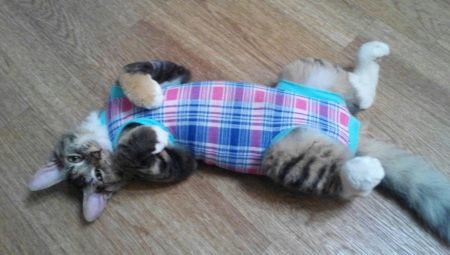After any surgical interventions, it is very important to ensure the conditions under which the healing process of sutures and incisions will be completed as soon as possible. But animals in such situations manifest their natural reflex. Cats tend to lick their wounds. Thus, animals in most cases successfully cure small abrasions on their body completely independently.
But in the case when it comes to the healing of postoperative sutures, such an intervention can provoke infection in them, which will significantly slow down the recovery of the animal.
What is it and why is it needed?
After sterilization or other operations, veterinarians instruct cats to wear so-called blankets. It is a fabric overlay on the lower body of the animal. The blanket covers the entire stomach and chest of the cat, thereby preventing the animal from reaching the postoperative sutures, because often cats do not just actively lick them, but also try to gnaw out medical threads on the cuts.
In addition, a tissue bandage will help protect the animal from poisoning with antiseptic drugs. In most cases, surgical sutures must be treated with medical means several times a day, at least in the first days after surgery. And swallowing such drugs in animals is highly undesirable.
An exception are those cases when subcutaneous sutures were used after surgery. For their healing, it is necessary that the skin be open and have constant access of air. Therefore, wearing blankets in the postoperative period is excluded.
The duration of the use of the bandage depends on the complexity of the operation, the size of the sutures, the general condition of the pet and the characteristics of the healing process. Usually, after uncomplicated interventions, the cat should wear blankets for 10-15 days. But these terms can vary both upward and downward. The decision on the final removal of the bandage is made by the veterinarian.
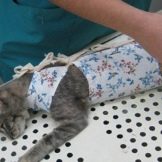


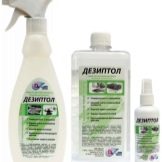
Sometimes immediately after surgery, a cat is put on a blanket in the veterinary clinic itself. There are times when the doctor simply prescribes wearing it, and the owner himself has to figure out how to tie it on the animal.
Added to this is another problem - so many cats and cats do not like to wear a bandage at all. The constant sensation of a slight constriction of the torso with tissue is unnatural for animals. Therefore, be prepared that in some cases your pet will resist you. Putting on blankets once and not taking off her entire postoperative period will not work, since in the first days the owner will need to process the stitches on the cat's body with prescribed antiseptic drugs.
But in fact, tying a bandage is not such a complicated procedure. Most pet owners master it very quickly.
And it’s better to get used to this process. Our tips and instructions will help you.
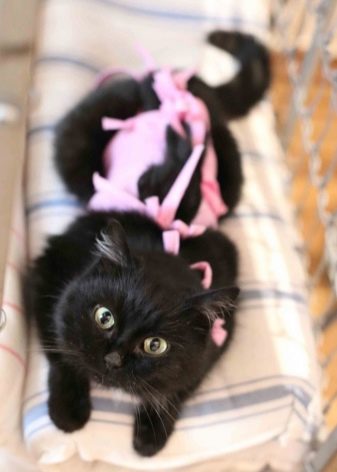
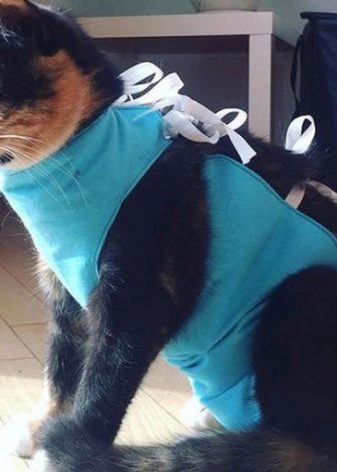
Donning Instructions
Most often, a blanket is attached to the body of the animal with the usual ties. Velcro options are available. Putting a cat in such a bandage is much easier, but velcro blankets are more expensive.
The first donning of blankets occurs immediately after surgery. Most often at this time the animal is still under anesthesia or only partially conscious. In this state, the cat does not show resistance, which greatly simplifies the process. It should be very neat and careful, do not make sudden movements while manipulating the body of the animal: fresh seams can very easily be damaged.
In the future, you will have to repeatedly process the wounds and put on a bandage on an already active animal. It is important to act as calmly as possible. If the cat or cat is nervous and resists, gently talk to your pet, pet him. Spread the bandage on the table and lay the cat on top of it with the tummy down.
It will be better if for the first time someone helps you - together it is much easier to carry out this process.
Let one person soothe and pet the animal, but in the meantime you can carefully and slowly rush to tie the shoelaces of the bandage according to the pattern.
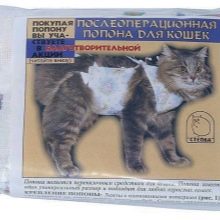
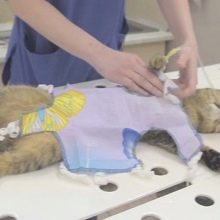

How to tie?
First make sure that you have correctly positioned the blanket. The reference point is symmetrical cutouts for the forepaws. The head of the animal should be located slightly in front of them, and the notches themselves will be in the area of the front axillary cavities of the animal.
A simple classic blanket has 14 laces for fixation, symmetrically located along its lateral edges. They will need to be tied on the back of the cat. Given that you have to periodically remove the bandage, you should not make knots too tight. But it is dangerous to tie the shoelaces too weakly: the animal can untie them with its teeth and subsequently get rid of the bandage.
- Tie a blanket on a cat you need from the head. Take the two very first shoelaces in front and connect them on the neck of the animal.
- The next two pairs of ribbons need to be tied crosswise in the area of the cat’s shoulder blades, i.e. the left eyelet from the second pair is connected to the right eyelet from the third pair, the right ribbon from the second pair to the ribbon from the third pair of ties located on the right side. Thus, you should get a crosshair of laces, which will be located above the withers.
- The following ribbons are tied in pairs on the back.
- The last two pairs of ties are fixed crosswise on the back of the cat's body.

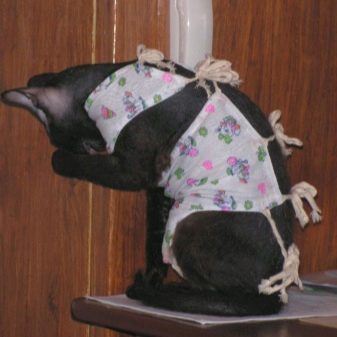
It is important to ensure that the postoperative dressing does not block the excretory openings of the animal: the anus and urinary tract.Otherwise, because of the inconvenience, the pet will actively try to take off the blanket. And you will have to face the fact that the bandage will soon be dirty.
The bandage should not squeeze the cat's body tightly. If you notice that the animal is moving stiffly, loosen the lacing.
It is best to have a second blanket in reserve.
Your pet may tear his postoperative dressing with his teeth or become very dirty, then you will need to replace it.

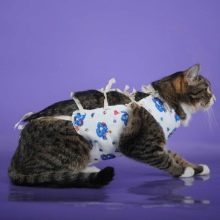
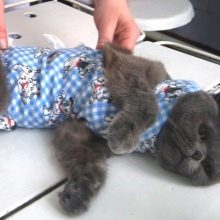
If the surgical suture is small, it is not necessary to remove the entire band to process it - free only that part of the body where the wound is located. So you save time and effort in the process of tying and fixing the bandage.
Do not leave the long ends of the shoelaces. The cat can easily pull their teeth, loosen or untie the knot.
It is allowed to take blankets for 15–20 minutes 2-3 times a day, especially if the animal does not get along well with it. But the cat at this time should be under your strict supervision. When trying to lick the wounds and sutures, you should immediately gently prevent this: distract the animal with a game or caress.
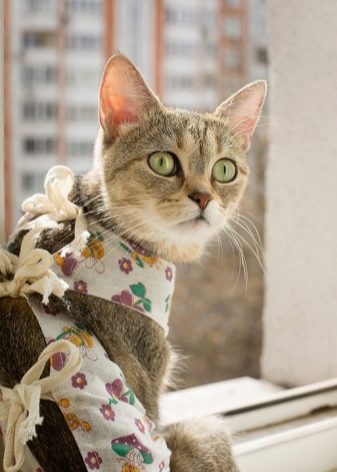
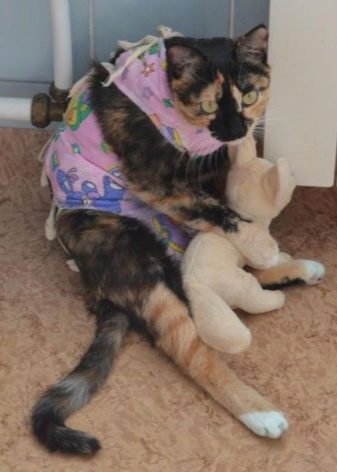
For information on how to put a blanket on a cat and properly tie it up, see the next video.
